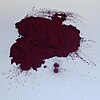Quinacridone pigments
Quinacridone pigments (QACs) are a group of organic pigments that are derived from the basic structure of the quinacridone . The first representatives of the pigment class were produced in 1935, but initially had no commercial significance. Although there are over a hundred representatives of the pigment class, many of them with several modifications , only a few have achieved any significance in the pigment market. The quinacridonequinone pigments are also included in the group of quinacridone pigments .
construction
| CI name | CI Constitution Number | colour | Number of modifications | Full name | image |
|---|---|---|---|---|---|
| Pigment Violet 19 | 73900 | bluish red to reddish purple | 4th | Quinacridone, β-modification | |
| Quinacridone, γ-modification | |||||
| Pigment red 122 | 73915 | bluish red (magenta, pink) | 3 | 2,9-dimethylquinacridone | |
| Pigment red 202 | 73907 | bluish red to purple | 3 | 2,9-dichloroquinacridone | |
| Pigment red 207 | 73900 + 73920 | yellowish red | 1 | Mixed crystal of quinacridone and 4,11-dichloroquinacridone | |
| Pigment red 209 | 73905 | red | 1 | 3,10-dichloroquinacridone |
properties
The unsubstituted quinacridone (CI Pigment Violet 19) shows a red (γ-modification) to red-violet (β-modification) color . Substituted quinacridones have colors from bright red (CI Pigment Red 209), coral red (CI Pigment Red 207) to magenta and pink (CI Pigment Red 122, CI Pigment Red 202). Quinacridonequinone pigments mostly have colors in the orange range, which are relatively cloudy compared to quinacridones. The area covered ranges from golden yellow (CI Pigment Orange 49), red-orange (CI Pigment Orange 48) to chestnut brown (CI Pigment Red 206).
Quinacridone pigments have very good weather resistance , high color strength and produce very pure colors. The chemical resistance as well as the temperature stability of most representatives is also outstanding. Typical of quinacridone pigments is their moderate hiding power (and thus high transparency ) and often poor dispersibility . In contrast, quinacridonequinone pigments have a slightly poorer weather resistance.
use
pigment
Quinacridones are used because of their properties, in particular their good weather resistance, for coloring paints (such as industrial and automotive paints ), printing inks , artist paints, weather-resistant emulsion paints, plastic coloring and the like. v. m. used. The most important commercial representatives are the β and γ modifications of the unsubstituted quinacridone (CI Pigment Violet 19) and 2,9-dimethylquinacridone (CI Pigment Red 122). Quinacridonequinone pigments are specialties for gold-colored metallic paints and are mainly used in the USA.
Organic semiconductor
Quinacridones are organic semiconductors (p-type) from the class of conjugated molecules . Due to the photoelectric properties and the high resistance, quinacridone pigments can be used for the production of relatively long-lasting organic solar cells . As an adsorbate , quinacridone pigments z. To as titanium dioxide - photocatalysts for the spectral range of the visible light to raise awareness. Quinacridone pigments are also in the development of highly efficient organic light emitting diodes (OLED) as a dopant in the organic emitter layer (eg.) Was used to the electroluminescence - quantum yield increase.
Fluorophore
Quinacridone derivatives (especially alkylated quinacridone pigments) are suitable as fluorescence probes in molecular biology and can be used as fluorescence sensors to detect metal ions .
Individual evidence
- ^ A b W. Herbst, K. Hunger: Industrial Organic Pigments . 3. Edition. Wiley-VCH, Weinheim 2004, ISBN 3-527-30576-9 , pp. 462 ff . (English).
- ↑ Bruce MacEvoy: synthetic organic pigments. quinacridone. In: handprint. watercolors . Retrieved in 2010 (English).
- ↑ M. Hiramoto et al .: Photoinduced Hole Injection Multiplication in p-Type Quinacridone Pigment Films. In: Jpn. J. Appl. Phys. 35/1996, pp. L349-L351.
- ↑ K. Manabe et al .: Long-life Organic Solar Cell Fabrication using Quinacridone Pigment. In: Chem. Lett: 1987, pp. 609-612.
- ^ H. Ding et al .: Preparation and characterization of mesoporous SBA-15 supported dye-sensitized TiO2 photocatalyst . In: Journal of Photochemistry and Photobiology A: Chemistry 169/2005, pp. 101-107.
- ↑ J. Kalinowski et al .: Injection-controlled and volume-controlled electroluminescence in organic light-emitting diodes . In: Synthetic Metals '76 / 1996, pp. 77-83.
- ↑ ZH Kafafi et al .: Electroluminescent properties of functional pi-electron molecular systems . In: Pure Appl. Chem. 71/1999, pp. 2085-2094.
- ^ JA Smith et al .: Acridones and Quinacridones: Novel Fluorophores for Fluorescence Lifetime Studies . In: Journal of Fluorescence 14/2004, pp. 151-171.
- ^ G. Klein et al .: A fluorescent metal sensor based on macrocyclic chelation. In: Chem. Commun. 6/2001, pp. 561-562.








